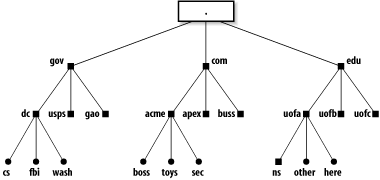Overview
DNS stands for Domain Name System. A domain is any logical or physical collection of related hosts or sites. A naming system is best visualized as an inverted tree of information that corresponds to fully qualified hostnames (see Figure 9-1).
 |
The parts of a fully qualified name are separated from one another with dots. For example:
here.uofa.edu
This name describes the machine here that is part
of the uofa subdomain of the
edu top-level domain. In Figure 9-1 the dot at the top is the
“root” of the tree. It is implied
but never[1] included in fully qualified
domain names:
here.uofa.edu.
↑impliedThe root corresponds to (is served by) actual machines.[2] Each has knowledge of all the top-level domains (such as gov, com, biz, uk, au, etc.) and the server machines for those domains. Each of the top-level domain’s servers knows of one or more machines with knowledge of the next level below. For example, the server for edu “knows” about the subdomains uofa, uofb, and uofc but might not know about anything below those subdomains, nor about the other domains next to itself such as com.[3]
A knowledgeable machine, one that can look up or distribute information about its domain and subdomains, is called a name server. Each little black square in Figure 9-1 represents a name server for a portion of a domain. Each is required to have ...
Get Sendmail, 3rd Edition now with the O’Reilly learning platform.
O’Reilly members experience books, live events, courses curated by job role, and more from O’Reilly and nearly 200 top publishers.

